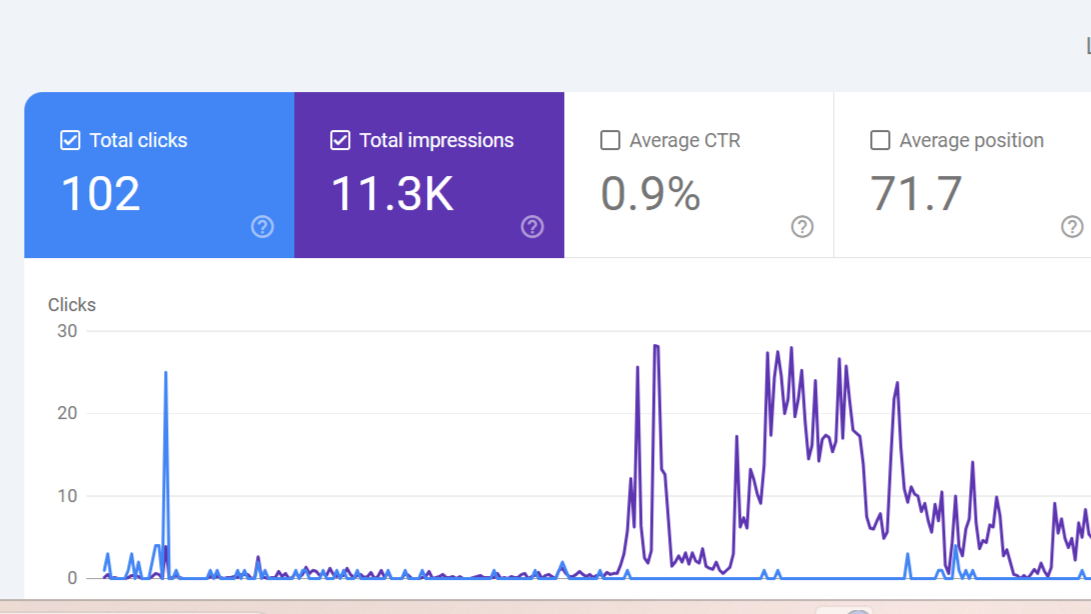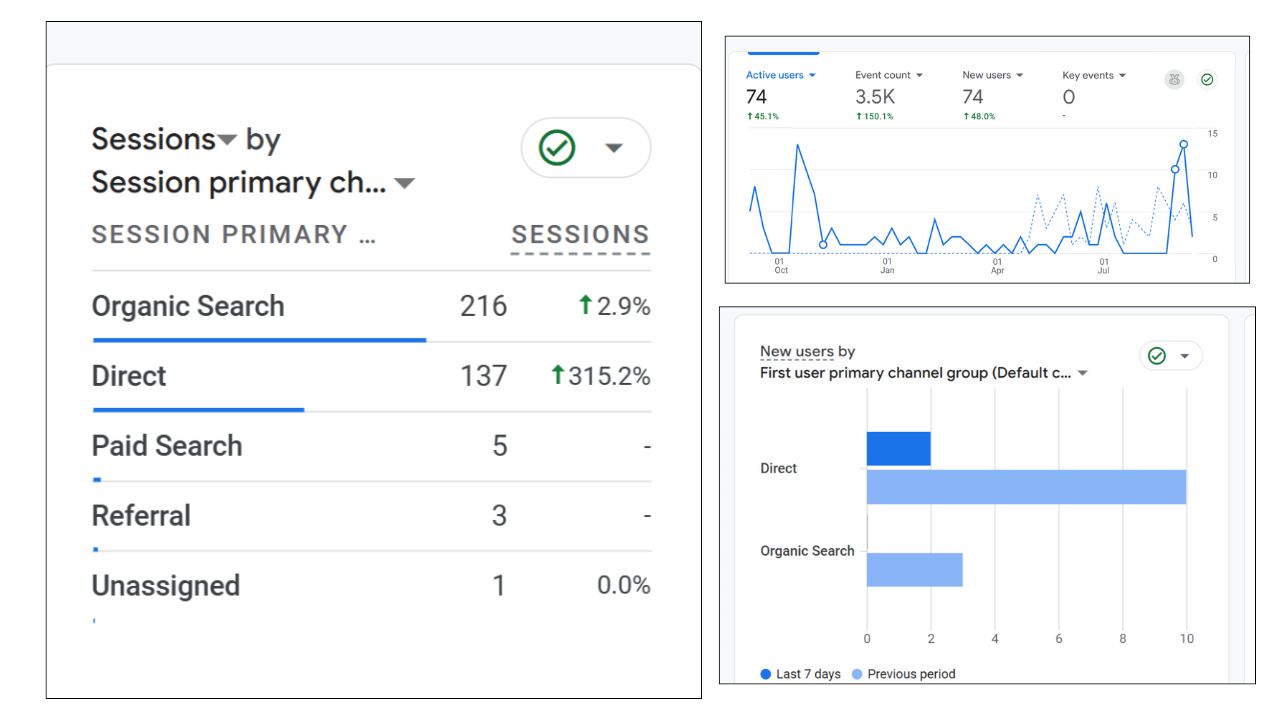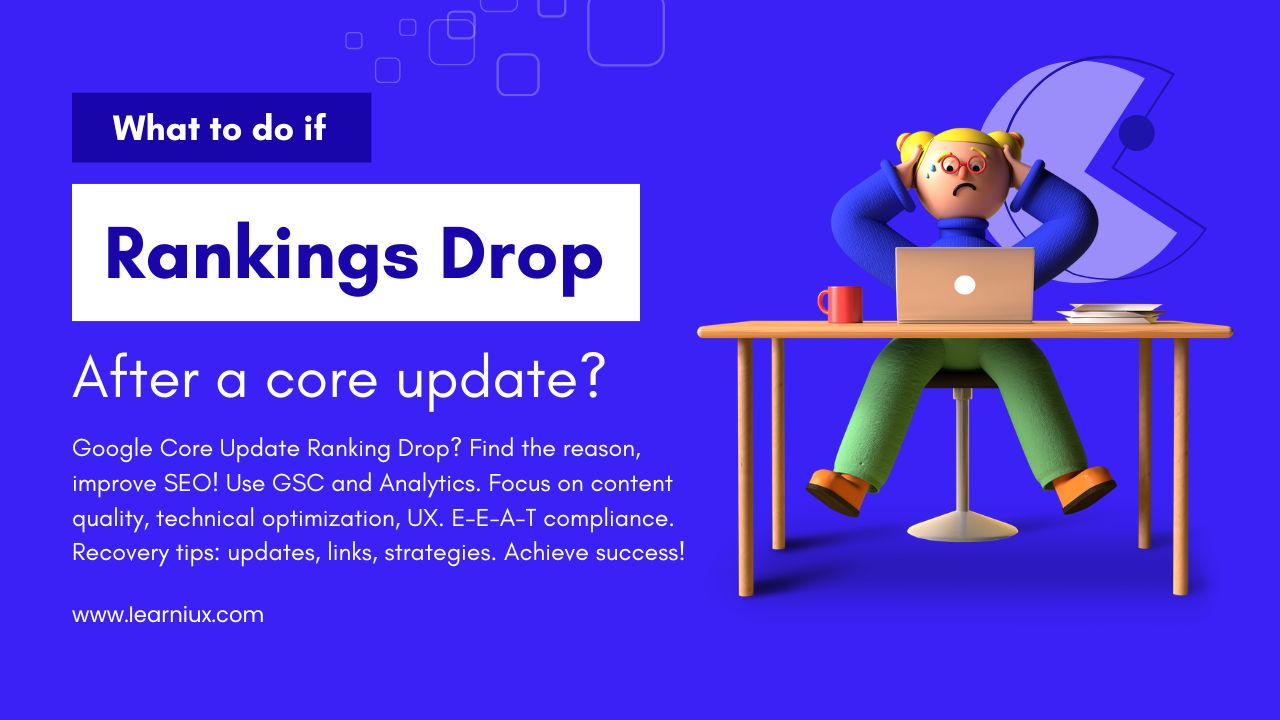Introduction
A drop in website rankings after Google Core Update is a common and challenging situation. These updates make major changes to the search engine’s algorithms, which can affect your website’s visibility on the Search Engine Results Page (SERP). In such cases, SEO professionals and website owners are likely to experience a significant drop in traffic and revenue. However, this situation is not permanent; with the right strategy and perseverance, you can improve your rankings again.

In this article, we will analyze the impact of the Core Update, share useful tools and methods to find the reasons for the ranking drop, and explain in detail practical steps to improve rankings. This guide, based on the fundamentals of Search Engine Optimization (SEO), will help you achieve not just a temporary solution, but long-term success. We will focus on SEO best practices, such as content quality, technical optimization, and user experience improvements, which will enable your website to cope with Google updates.
Core Updates are Google efforts to provide users with more accurate, reliable, and useful search results. Such updates benefit some websites, while harm others. If your rankings have dropped, it is a sign that your website needs some improvements. With the steps mentioned in this article, you can overcome this challenge and strengthen your SEO strategy.
What is a Core Update?
Google Core Updates are major changes to the search algorithm and ranking system, designed to provide users with more relevant and high-quality search results. These updates occur several times a year and have a broad impact on a website’s ranking. During a Core Update, Google refines its ranking factors, such as content quality, website credibility, and user experience.
For example, in a Core Update, Google places more emphasis on E-E-A-T (Experience, Expertise, Authoritativeness, Trustworthiness), which gives preference to websites with high-quality content. These updates are typically rolled out over a period of weeks, and during that time, rankings can fluctuate, known as the “Google Dance.” It’s important for SEO professionals to understand that a Core Update is not a penalty; it’s simply to improve the quality of search results.

Throughout the history of Core Updates, several updates have had a major impact on a website’s ranking. For example, some updates have been more impactful for websites in the YMYL (Your Money or Your Life) category, such as health, finance, and legal sites. These updates are announced on Google’s Search Central blog, and are discussed in the SEO community. Understanding the purpose of the Core Update is the first step in the recovery process, as it helps you align your SEO strategy with Google’s expectations.
Why the Core Update Affects Rankings
In the Core Update, Google focuses on content quality, user experience, and website credibility. If your website falls short on these criteria, your rankings may suffer. For example, if your content is old, low-quality, or doesn’t match user intent, Google will give it lower priority.

The main reason for the Core Update’s impact is Google’s focus on user-centric search results. These updates refine the algorithm so that it can recognize more natural language, search intent, and content depth. For example, if a website uses too much AI-generated content that isn’t valuable, its rankings may drop. Also, the quality of backlinks and spam factors are also important, which affects sites with manipulative links.
From an SEO perspective, the Core Update impacts rankings because it assesses the overall quality of a website. If your site is technically weak, such as having slow loading times or not being mobile-friendly, these updates will expose it. Additionally, your rankings can also be affected by competitor improvements, as updates make rankings more competitive. Understand that these changes are not permanent; you can recover with the right SEO improvements.
Finding the Reason for a Ranking Drop
Analyzing why your rankings dropped after a Core Update is a fundamental step in recovery. This requires a data-driven approach. First, you need to verify that the ranking drop actually happened. Tracking tools can sometimes be inaccurate, so use reliable sources like Google Search Console and Analytics.
To find the reason for a ranking drop, compare your traffic data to the date of the update. It can take a few weeks for this update to roll out, so don’t panic right away. Collect data and look for patterns, such as higher impact on certain keywords or pages. This analysis will help you focus.
Use Google Search Console
Google Search Console (GSC) is a great tool to find the cause of a ranking drop. Check the clicks, impressions, and average position in the Performance Report. Compare the data to the date of the Core Update to see which keywords or pages were impacted.

For example, if a page has decreased impressions but the click-through rate is the same, this is an indication of a ranking drop. Use the Coverage Report in GSC to check for indexing issues, such as noindex tags or crawl errors. Also, verify that specific pages are indexed using the URL Inspection tool. Regular use of GSC in your SEO strategy speeds up the diagnostic process.
Check Analytics Data
Find patterns of traffic drops using Google Analytics (GA) or other analytics tools. Check organic search traffic in Acquisition > All Traffic > Channels and identify affected pages in the Landing Pages report.
After the Core Update, check device-specific data; for example, if mobile traffic has decreased, mobile optimization could be the issue. Assess user engagement by looking at metrics like Bounce Rate and Session Duration. If bounce rate has increased, there could be a problem with the content or UX. Using GA in SEO analysis allows you to make data-driven decisions.
Competitor Analysis

If your competitors’ rankings have improved, study their content, backlinks, and SEO strategies. For example, if they have updated their content or acquired new backlinks. This analysis will help you identify your weak areas and inspire you to improve your SEO strategy. Competitor analysis is a crucial step in Core Update recovery, as it helps you understand changes in the market.
Steps to Improve Rankings After a Core Update
A structured plan is essential to improve rankings after a Core Update. First, don’t panic and wait for the update to complete. Then, focus on content, technical SEO, and UX. These steps are based on SEO best practices and provide long-term benefits.
During the recovery process, track changes and measure results. For example, monitor rankings in GSC after a content update. Track progress using SEO tools like Rank Tracker. This process can be time-consuming, but consistent efforts pay off.
Improve Content Quality
The Google Core Update prioritizes high-quality content. Content is the cornerstone of SEO, so improving its quality is a priority.
- Prioritize user intent: Your content should provide direct and clear answers to user questions. For example, for “best SEO tools,” provide users with tool comparisons, benefits, and examples. Look at Google’s “People Also Ask” and related searches to understand search intent.
- Update content: Update old or outdated information with new and accurate information. Don’t just change the date; add new insights, statistics, and examples. For example, include new algorithm changes in SEO guides.
- Focus on E-E-A-T: Include Expertise, Authoritativeness, Trustworthiness, and Experience. Provide author identification, credible references, and clear information. Add author bios, link to professional profiles, and include original research. This is especially important for YMYL content.
To improve your content, study your competitors’ content and make yours more comprehensive. Use short paragraphs, subheadings, bullet points, and visuals to improve readability. Avoid AI-generated content and add a human touch, such as personal experiences or case studies. These changes make the content more valuable in SEO and improve rankings.
Optimize Technical SEO
Technical SEO plays a key role in the Core Update, as it affects the crawlability and indexing of a website.
- Page Speed: Improve page loading times using Google PageSpeed Insights. Use image compression, lazy loading, and Content Delivery Network (CDN). Slow pages affect Core Web Vitals, which are ranking factors.
- Mobile Friendly: Make sure your website works properly on mobile devices. Use GSC’s Mobile Usability Report and fix issues, such as content that is larger than the screen or clickable elements that are too close together.
- Crawling and Indexing: Make sure Google can crawl your website properly by checking your robots.txt and sitemap. Merge or remove duplicate content, and use canonical tags.
Use tools like Screaming Frog or Sitebulb for technical SEO audits. Check for movements or redirects, and view crawl stats in GSC. These improvements increase the overall performance of the website in SEO and reduce the impact of the Core Update.
Improve User Experience
User experience (UX) is a big focus in the Core Update, as it measures user satisfaction.
- Improve Navigation: Optimize menus and links to make it easier for users to navigate the website. Improve internal linking to connect relevant pages.
- Core Web Vitals: Improve LCP (Largest Contentful Paint), FID (First Input Delay), and CLS (Cumulative Layout Shift) metrics. Use page speed optimization and stable layouts.
- Visual appeal: Use attractive designs and clear layouts. Avoid intrusive pop-ups and increase readability.
Collect user feedback and use heatmap tools like Hotjar to improve UX. These changes increase dwell time and engagement in SEO, which indirectly improves rankings.
Backlinks and Outreach
High-quality backlinks increase your website’s credibility, which is important in the Core Update.
- Remove bad links: Remove spammy or low-quality links using the Google Disavow Tool. Audit your backlink profile and identify toxic links.
- Get new links: Build backlinks through guest posts, partnerships, or outreach to related websites. Create link-worthy content, such as industry reports or infographics.
In your backlink strategy, focus on quality, not quantity. Look for unlinked brand mentions and ask for links. This builds authority in SEO and helps you recover rankings.
Long-term strategy
Take a long-term approach to mitigate the impact of the Core Update. SEO is an ongoing process, so make regular improvements.
- Regular content audits: Regularly check and improve the content on your website. Identify and update content gaps.
- Keyword research: Focus on new and relevant keywords that will attract your audience. Focus on long-tail keywords and search intent.
- Adherence to Google guidelines: Adhere to Google’s Webmaster Guidelines and use White Hat SEO techniques. Stay updated on updates and adapt your strategy.
In long-term SEO, focus on brand building and user engagement. Diversify traffic through social media and email marketing. This protects against the impact of the Core Update.
Avoid Mistakes
Avoid some mistakes when trying to improve rankings after a Core Update, which can make things worse.
- Over-optimization: Avoid keyword stuffing or unnecessary links. Use natural SEO methods.
- Content Deletion: Don’t immediately delete content that has dropped in ranking; improve it instead.
- Hasty Changes: Don’t make major changes without understanding the implications of the updates. Wait for the update rollout to complete.
By avoiding these mistakes, you can keep your SEO strategy safe and reduce unnecessary risk.
Conclusion
A drop in rankings after the Google Core Update can be disappointing, but with the right analysis and strategy, you can improve your rankings again. Focus on content quality, technical SEO, and user experience. Set your website up for long-term success by conducting regular audits and following Google’s guidelines.
SEO is an evolving field, and changes like the Core Update make it more user-centric. By following this guidance, you will not only recover, but also be prepared for the next updates. Consistency and adaptation are the keys to successful SEO.
FAQs
What is a Google Core Update and how does it affect SEO?
Google Core Updates are major changes to the search algorithm that are designed to improve the quality of search results. These updates focus on content quality, user experience, and website trustworthiness. If your website falls short on these criteria, it can lead to a drop in rankings. For example, sites with low-quality content or technical errors are affected. For SEO, these updates give you the opportunity to improve your strategy. You can increase your rankings again by working on content and technical optimization. These updates occur regularly, so it’s important to keep up with them.
How to recognize a ranking drop after a Core Update?
You can identify a ranking drop by checking the Performance Report in Google Search Console. This shows changes in clicks, impressions, and average position. A drop in organic traffic in Google Analytics is an indication of a drop. Check to see if specific keywords or pages are affected. It is important to compare the data with the date of the Core Update. Ranking tracking tools like SEMrush or Ahrefs are also helpful. Once you identify the drop, analyze the reasons and start improving.
What to do if your rankings drop after a Core Update?
First, don’t panic and wait for the update to complete. Identify the affected pages and keywords by checking the data in Google Search Console and Analytics. Focus on improving content quality, optimizing technical SEO, and enhancing user experience. Follow E-E-A-T (Experience, Expertise, Authoritativeness, Trustworthiness). Check your backlink profile and remove bad links. Follow regular audits and White Hat SEO practices. These steps are effective for ranking recovery.
Some tips on how to improve content quality?
Content should be relevant and informative to the user’s intent. Update old or outdated information with new statistics and references. Emphasize E-E-A-T; add author attribution and reliable references. Study your competitors’ content and create content that is more comprehensive and valuable than yours. Increase readability by using short paragraphs, subheadings, and visuals. Avoid AI-generated content and include personal experiences or case studies. These changes make content more effective in SEO.
What to check to improve technical SEO?
Check page speed, mobile friendliness, and crawling/indexing errors. Improve loading times using Google PageSpeed Insights; image compression and CDNs are helpful. Fix errors in Google Search Console’s Mobile Usability Report. Configure robots.txt and sitemap properly. Check for duplicate content and redirects. Perform technical audits with tools like Screaming Frog. These improvements increase the SEO performance of the website and help to deal with the impact of the Core Update.
Why is user experience (UX) important in the Core Update?
In the Core Update, Google prioritizes user satisfaction, which depends on UX. Website navigation should be simple and intuitive. Core Web Vitals (LCP, FID, CLS) need to be improved. Attractive design, clear layout, and avoiding intrusive pop-ups are important. Understand user behavior using heatmap tools like Hotjar. Improving UX increases dwell time and engagement, which indirectly improves rankings for SEO. Following Google’s UX criteria helps in success in the Core Update.
How do backlinks help in ranking recovery?
High-quality backlinks increase the credibility and authority of a website. Remove bad or spammy links with the Google Disavow Tool. Get new, relevant backlinks through guest posts, partnerships, or outreach. Create link-worthy content, such as infographics or industry reports. Perform regular backlink profile audits, such as with Ahrefs. Focus on quality, not quantity. This is important for improving SEO rankings and mitigating the effects of the Core Update.
How long does it take for rankings to recover after a Core Update?
The timing of ranking recovery depends on the severity of the website issues. Typically, it can take anywhere from a few weeks to a few months after the update. It takes time for Google to crawl and index the revised content and technical changes. Regular monitoring and consistent improvements are required. Track rankings and traffic in Google Search Console. There is a chance of recovery in the next Core Update, if the improvements are appropriate. Patience and consistency are key.
What should be the long-term SEO strategy for the Core Update?
For long-term SEO, conduct regular content audits, keyword research, and follow Google’s guidelines. Create high-quality, user-centric content. Work consistently on technical SEO and UX. Focus on long-tail keywords and search intent. Build backlinks and increase brand authority. Diversify traffic through social media and email marketing. These strategies will help protect against the impact of the Core Update and ensure consistent SEO success.
What mistakes should you avoid after the Core Update?
Avoid over-optimization, such as keyword stuffing or manipulative links. Don’t immediately delete content that has dropped in ranking; improve it instead. Don’t rush into making big changes, as it takes time for the update rollout to complete. Avoid using AI-generated or low-quality content. Failure to follow Google’s Webmaster Guidelines can result in penalties. Don’t make decisions without data analysis. By avoiding these mistakes, you can keep your SEO strategy safe and speed up recovery.






















































